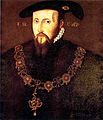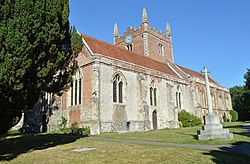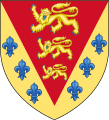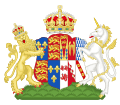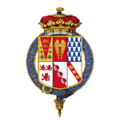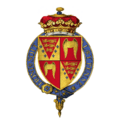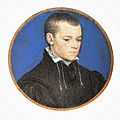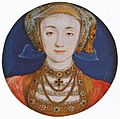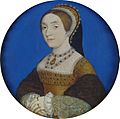Elizabeth Seymour, Lady Cromwell facts for kids
Quick facts for kids
Elizabeth Seymour
|
|
|---|---|
| Baroness Cromwell Baroness St. John |
|
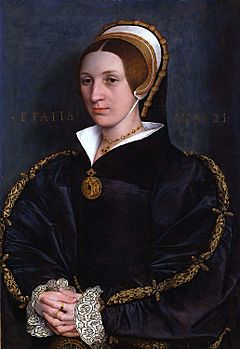
Portrait of a lady, probably a Member of the Cromwell Family, perhaps Elizabeth Seymour, around 1535–1540, Hans Holbein the Younger
|
|
| Born | c. 1518 |
| Died | 19 March 1568 (aged 49–50) |
| Buried | St. Mary's Church, Basing, Hampshire 51°16′17″N 1°02′48″W / 51.271389°N 1.046667°W |
| Spouse(s) | |
| Issue |
|
| Father | Sir John Seymour |
| Mother | Margery Wentworth |
Elizabeth Seymour (born around 1518 – died 19 March 1568) was a younger daughter of Sir John Seymour and Margery Wentworth. Her family lived at Wulfhall in Wiltshire, England. Elizabeth and her sister, Jane, worked in the royal household. They served Anne Boleyn, who was the second wife of Henry VIII.
King Henry VIII wanted a son to be his heir. His first wife, Catherine of Aragon, had only a daughter, Mary. His marriage to Anne Boleyn also resulted in a daughter, Elizabeth. When Anne lost a baby boy in 1536, the King decided she could not give him a male heir. He became interested in Jane Seymour.
In May 1536, Anne Boleyn was accused of treason (being disloyal to the king). She was quickly put on trial and executed. Just eleven days later, on 30 May 1536, Henry VIII married Jane Seymour. Elizabeth did not join her sister's household right away. However, she later served two of Henry VIII's other wives: Anne of Cleves and Catherine Howard. Jane Seymour died on 24 October 1537, shortly after giving birth to a healthy son, Edward VI.
Elizabeth lived during the reigns of four Tudor monarchs. She was married three times. Her first husband was Sir Anthony Ughtred, who was the Governor of Jersey. He died in 1534. In 1537, she married Gregory Cromwell, 1st Baron Cromwell. He was the son of Thomas Cromwell, who was a very important minister to King Henry VIII. Gregory died in 1551. Her third husband was Sir John Paulet, whom she married in 1554.
Contents
The Seymour Family
The Seymour family got their name from a place in France called St. Maur-sur-Loire. Over many years, the family gained land and importance in England. Elizabeth's father, Sir John Seymour, was a descendant of this family.
Sir John Seymour was born in 1474. He became a knight in 1497 for helping King Henry VII against rebels. He also held important local positions, like sheriff of Wiltshire. He was present at important events with King Henry VIII, including battles and meetings with the King of France. Sir John Seymour died on 21 December 1536.
He married Margery Wentworth. Her family also had important connections. Sir John and Margery had ten children together. They were married on 22 October 1494.
Their children included:
- John Seymour (died young)
- Edward Seymour, 1st Duke of Somerset, who later became a powerful Lord Protector for King Edward VI.
- Sir Henry Seymour
- Thomas Seymour, 1st Baron Seymour of Sudeley, who later married Catherine Parr, King Henry VIII's last wife.
- John Seymour (died young)
- Anthony Seymour (died young)
- Jane Seymour, who became Queen Consort to Henry VIII.
- Margery Seymour (died young)
- Elizabeth Seymour (born around 1518 – died 1568)
- Dorothy Seymour
-
Jane Seymour, portrait miniature around 1536–37
Out of their ten children, six survived to adulthood. These were three sons (Edward, Henry, and Thomas) and three daughters (Jane, Elizabeth, and Dorothy). Edward, Thomas, Jane, and Elizabeth all worked at the royal court. Edward and Thomas were later executed during King Edward VI's reign. Henry Seymour was not as ambitious as his brothers, so he avoided their fate.
Elizabeth's Early Life
Elizabeth Seymour was likely born at Wulfhall around 1518. Her letters show she was smart and clever. She was also good at needlework. Elizabeth played an important role in the 1530s and 1540s. This was when her father-in-law, Thomas Cromwell, and her brother, Edward, gained power. Elizabeth and her sister, Jane, worked in the household of King Henry VIII's second wife, Anne Boleyn. Anne was their second cousin. Elizabeth married three times and had seven children from her first two marriages. She is most known as the wife of Gregory Cromwell.
First Marriage
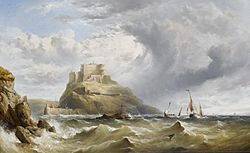
By July 1530, Elizabeth had married Sir Anthony Ughtred. He was the Governor of Jersey. This was his second marriage. They had two children:
- Sir Henry Ughtred, born around 1533 or 1534 in Jersey.
- Margery Ughtred, born around 1535.
In 1531, King Henry VIII gave Elizabeth and Sir Anthony some lands. Elizabeth worked for Queen Anne Boleyn, which helped her husband's career. In 1532, Sir Anthony Ughtred was made captain and Governor of Jersey. This was likely due to Anne Boleyn's influence. He stayed in this job until he died.
Sir Anthony Ughtred died on 6 October 1534 in Jersey. He was buried in Mont Orgueil Castle. After his death, Elizabeth returned to Yorkshire. Her daughter, Margery, was probably born there. Her young son, Henry, stayed in Jersey for a while.
The Queen's Sister
When Queen Anne Boleyn did not have a son, the Seymour family became more powerful. Jane Seymour replaced Anne in the King's favor. In March 1536, Elizabeth's brother, Edward Seymour, gained important positions at court. He and his wife, along with Jane, were given special rooms at the palace.
In May 1536, Anne Boleyn was sent to the Tower of London. She was accused of treason. While Anne awaited her trial, Jane Seymour was preparing for her wedding. She was given fine clothes and served by the King's staff. On 30 May 1536, King Henry VIII married Jane. A week later, Edward Seymour was given a new title and many lands. His brother, Thomas Seymour, also gained important positions.
Elizabeth had supported Anne Boleyn. So, she was not part of Queen Jane's household at first. There is no clear sign that Elizabeth gained much from her sister's royal status until Jane became pregnant in 1537. The news of a royal baby made Elizabeth a more valuable bride.
In March 1537, Elizabeth was a young widow with little money. She wrote to Thomas Cromwell, a powerful minister, asking for help. Cromwell suggested she marry his only son, Gregory. By June, Elizabeth had accepted the offer.
Second Marriage
which doth comfort me most in the world, that I find your lordship is contented with me, and that you will be my good lord and father the which, I trust, never to deserve other, but rather to give cause for the continuance of the same.
—Elizabeth Cromwell, letter to her father-in-law, Thomas Cromwell, 1537
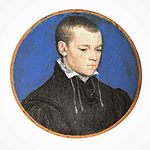
On 3 August 1537, Elizabeth married Gregory Cromwell. Elizabeth's brother, Edward Seymour, wrote to Thomas Cromwell. He hoped Elizabeth and Gregory would soon have a nephew for him.
The couple had five children:
- Henry Cromwell, 2nd Baron Cromwell, born before March 1538.
- Edward Cromwell, born 1539, died young.
- Thomas Cromwell, born around 1540.
- Katherine Cromwell, born around 1541, likely named after Queen Catherine Howard.
- Frances Cromwell, born around 1544.
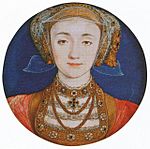
In November 1537, Elizabeth and Gregory attended Queen Jane's funeral. Jane's death was a blow to the Seymour family. It also affected Thomas Cromwell's power.
Their first child, Henry, was born in 1538. The family lived at Lewes Priory in Sussex. Another son, Edward, was born in 1539.
Gregory Cromwell seemed to care deeply for his wife and children. In December 1539, he wrote to Elizabeth from Calais. He was waiting to welcome King Henry VIII's new wife, Anne of Cleves. He called Elizabeth his "loving bedfellow" and asked for news of her and their "little boys." In January 1540, Elizabeth joined the household of the new Queen, Anne of Cleves.
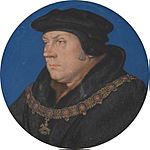
Thomas Cromwell was at the peak of his power. However, his enemies were gaining strength. He was arrested on 10 June 1540, accused of treason. He was taken to the Tower and his belongings were seized. He was condemned without a trial. We don't know where Gregory and Elizabeth were at this time.
Thomas Cromwell wrote a letter from the Tower to the King. He pleaded for mercy for his son and family. Elizabeth also wrote to King Henry VIII. She assured him of her and her husband's loyalty. She asked for his kindness towards them. This letter was likely written while Thomas Cromwell was still in the Tower. Her brother, Edward, probably advised her to write it.
Thomas Cromwell was executed on 28 July 1540. This was the same day the King married Catherine Howard. Gregory and Elizabeth were not punished. However, they had no home or income. They had to rely on family and friends. The King was kind to them. Elizabeth was made an attendant lady in Queen Catherine Howard's household.
On 18 December 1540, Gregory Cromwell was given the title Baron Cromwell. This was a new title, not a return of his father's old one. In February, he received lands that had belonged to his father.
At King Edward VI's coronation in 1547, Elizabeth's husband Gregory and her brother Henry became knights. Her brother Thomas was found guilty of treason and executed in 1549.
Elizabeth became a widow again in 1551 when Gregory Cromwell died from a disease called sweating sickness. He was buried at Launde Abbey. His tomb is still there today.
Elizabeth's brother, Edward, Duke of Somerset, was executed in 1552. His wife was imprisoned. Edward's four younger daughters were placed in Elizabeth's care. She received money to provide for them. However, caring for her nieces was difficult for Elizabeth. In October 1552, she wrote to Sir William Cecil. She asked to be relieved of her nieces, who were not easy to manage. Her own family was not nearby to help. Her nieces stayed with her until their mother was released from the Tower in 1553.
Third Marriage
Between March and April 1554, Elizabeth married Sir John Paulet. This was his second marriage. They did not have any children together. Elizabeth's two oldest sons married John Paulet's daughters. Henry Ughtred married Elizabeth Paulet after 1557. Henry Cromwell married Mary Paulet before 1560. We don't know much about Elizabeth's later life. However, she and her husband appear in records related to her son Henry Cromwell's affairs.
Death
Elizabeth died on 19 March 1568. She was buried on 5 April in St. Mary's Church, Basing, Hampshire. Her husband, John Paulet, later married again. He became the Marquess of Winchester in 1572.
Arms of Seymour
The Seymour family was granted a special addition to their coat of arms. This was an augmentation of honour. It was given to Edward Seymour after King Henry VIII married Jane Seymour. This special design included three lions of England and six fleurs-de-lys (lily flowers). You can see six fleurs-de-lys on the sleeve of the lady in the Holbein portrait at the top of this page.
Portraits
In 1909, an art historian named Lionel Cust thought a portrait by Hans Holbein the Younger was of Queen Catherine Howard. This painting had belonged to the Cromwell family for many years. The portrait shows the person at age 21. It was long thought to be Catherine Howard. However, now experts believe the lady is likely a member of the Cromwell family.
The portrait shown on this page is from around 1535–1540. It is displayed at the Toledo Museum of Art. It is called Portrait of a Lady, probably a Member of the Cromwell Family. Another version of the portrait is at Hever Castle. The National Portrait Gallery also has a similar painting.
Art historian Roy Strong suggested that the portrait in the Toledo Museum of Art might be Elizabeth Seymour. She was the wife of Gregory Cromwell, 1st Baron Cromwell. He noted that the painting has links to the Cromwell family. He also said the clothing style matches other portraits from that time.
Historians Antonia Fraser and Derek Wilson also believe the portrait is likely Elizabeth Seymour. Antonia Fraser pointed out that the lady looks similar to Jane Seymour. The lady in the portrait wears black, which could mean she is a widow. Derek Wilson noted that Thomas Cromwell arranged for his son Gregory to marry Elizabeth Seymour in 1537. This was an important event for the family, worth capturing in a portrait.
Images for kids
-
Portrait of a lady, probably a Member of the Cromwell Family, perhaps Elizabeth Seymour, around 1535–1540, Hans Holbein the Younger
-
Jane Seymour, portrait miniature around 1536–37, Lucas Horenbout
-
Mont Orgueil Castle, Jersey
-
Anne Boleyn, portrait at Hever Castle
-
Jane Seymour, Queen of England, Hans Holbein the Younger
-
Possibly Gregory Cromwell, around 1535–1540, Hans Holbein the Younger
-
Portrait Miniature of Anne of Cleves, Hans Holbein the Younger
-
Portrait of Thomas Cromwell, wearing the Garter collar (around 1485-1540)
-
Catherine Howard, miniature by Hans Holbein the Younger
See also
 In Spanish: Elizabeth Seymour para niños
In Spanish: Elizabeth Seymour para niños


